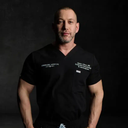Thank you for your question. You are 58-years-old, and noticed over the past 2 years that although you’ve had a good head of hair, you have receding temples you’re not bothered by, and have thinning in the crown area which you are able to cover with hair. You’re asking if minoxidil is of any value for someone your age.



